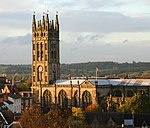Lord Leycester Hotel
Buildings and structures in WarwickGrade II listed buildings in WarwickshireHotels in Warwickshire
The Lord Leycester Hotel, often known simply as the Lord Leycester, is a former hotel in Warwick, England, that is located on Jury Street in the centre of the town. The building has variously been private housing, a hotel, and an inn during its history. Both the main building and the annexe are Grade II-listed buildings.
Excerpt from the Wikipedia article Lord Leycester Hotel (License: CC BY-SA 3.0, Authors).Lord Leycester Hotel
Jury Street,
Geographical coordinates (GPS) Address External links Nearby Places Show on map
Geographical coordinates (GPS)
| Latitude | Longitude |
|---|---|
| N 52.2818 ° | E -1.5865 ° |
Address
Jury Street 17;19
CV34 4EH , Cliff Hill
England, United Kingdom
Open on Google Maps









